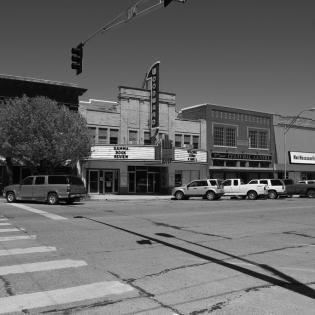What Is a Community?
This lesson introduces the definition of a community and explores how communities come together to help or address a need.
Photo credit: Woodward Downtown by Becky McCray is licensed under CC BY 2.0
The learner will:
- define community and describe its attributes.
- recognize that communities form when people work together for a common purpose.
- read-aloud copy of Humphrey the Lost Whale: A True Story by Wendy Tokuda
Reflect by asking, “Are you large like Humphrey or small like the people helping Humphrey?” So do you think you can help someone who is larger than you? What are some ways we can make an impact in our community?
Instructions
Anticipatory Set:
Display 5-10 photos of the familiar people in the group or community. Include a photo of a whale in the set of photos. Ask, "Which individual does not belong in the same community as the others?"
Together, make a list of attributes of the community we thrive in/belong in. Brainstorm a list of what the whale's community might include. Compare the lists. Save the lists to revisit later.
Introduce the story entitled: Humphrey the Lost Whale: A True Story, by Wendy Tokuda. Flip through the pictures and ask them to identify any communities they notice in the images.
Read the story aloud.
After reading, discuss the following questions:
- What is the problem? How do you know that is the problem?
- How was the problem solved? Could there have been a different solution?
- What would have happened if the community didn't come together to help the whale?
Define community as a group of people living in the same place or having a shared interest or purpose.
Call attention to how the people came together to help Humphrey. They saw a need and formed a community of people who were not from the same neighborhood or town, but they cared about helping this whale. They grew to care for each other too because they shared a purpose.
Revisit the list from above. What does the group of people helping Humphrey have in common with our community of people that live or work together?
Emphasize that in a healthy community, people want to work well together or have a friendly place to live. They support each other and work together for the common good.
Ask, "Do you think people in a community should do things without getting paid to make the community better (using their time, talent, or treasure)?" Discuss why and brainstorm examples of things they can do without asking permission or for the good of all (be kind, clean up, don't allow others to get hurt, do good work, volunteer, organize a team).
You may decide as a group to give time, talent, or treasure to address a need or improve a place. Learners may want to address an issue related to a local environmental need or to speak up for someone who is treated unfairly.
Invite a guest from a local nonprofit who tells the group about their work and what is needed to help the nonprofit do its work. The youth may decide together how they can share their time, talent, or treasure to help them meet an identified need. For example, they can make signs to help cats at the Humane Society get adopted.
Philanthropy Framework
-
Strand PHIL.I Definitions of Philanthropy
-
Standard DP 01. Define Philanthropy
-
Benchmark E.3 Recognize that citizens have a responsibility for the common good as defined by democratic principles.
-
-
Standard DP 03. Names and Types of Organizations within the Civil Society Sector
-
Benchmark E.1 Name and recognize the civil society sector as a separate part of the community.
-
-
Standard DP 04. Operational Characteristics of Nonprofit Organizations
-
Benchmark E.1 Describe how citizens organize in response to a need.
-
-
-
Strand PHIL.II Philanthropy and Civil Society
-
Standard PCS 04. Philanthropy and Geography
-
Benchmark E.1 Name examples of civil society organizations in the community.
-
Benchmark E.2 Identify and describe how civil society organizations help the community.
-
-
Standard PCS 05. Philanthropy and Government
-
Benchmark E.1 Define community as the degree that people come together for the common good.
-
Benchmark E.7 Describe why the classroom, school, or neighborhood is a community governed by fundamental democratic principles.
-
-
-
Strand PHIL.III Philanthropy and the Individual
-
Standard PI 01. Reasons for Individual Philanthropy
-
Benchmark E.4 Give an example of how citizens act for the common good.
-
-
